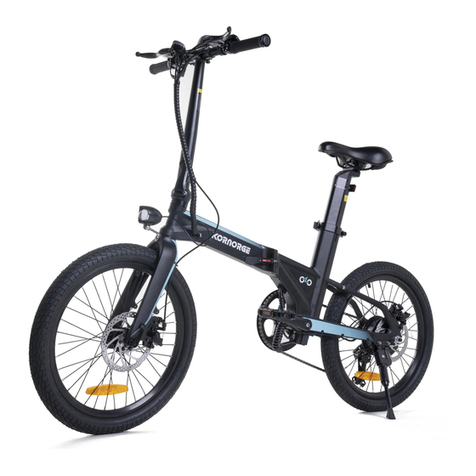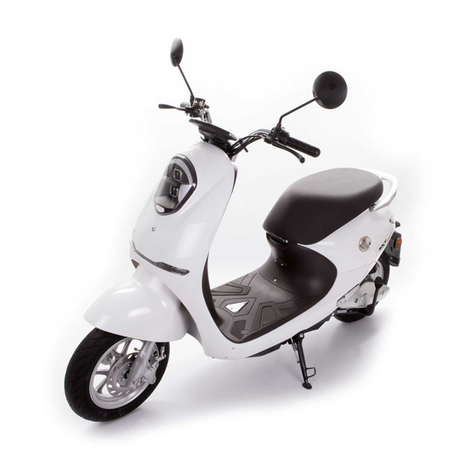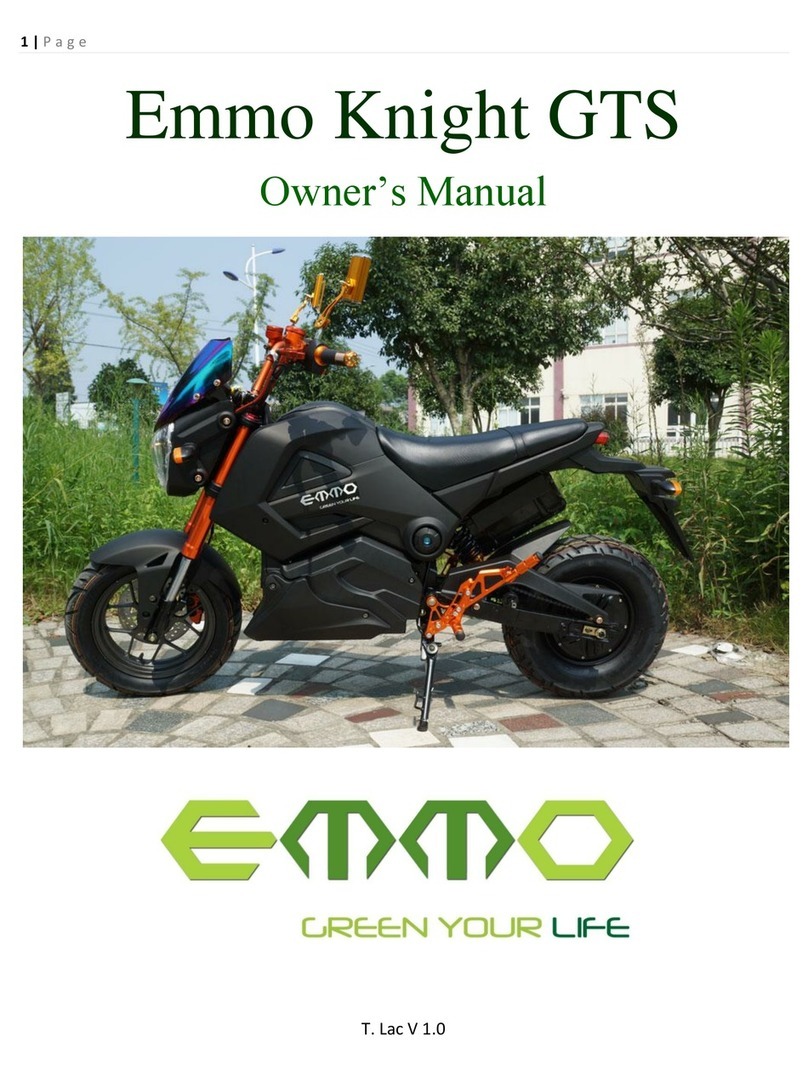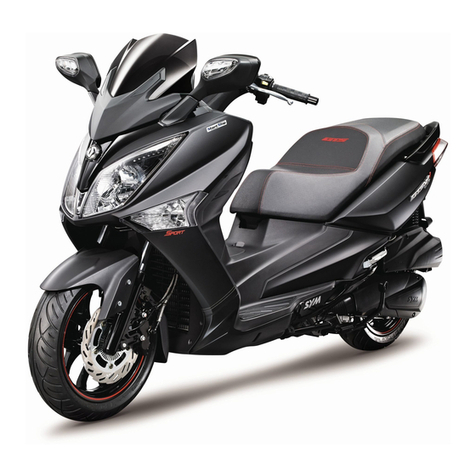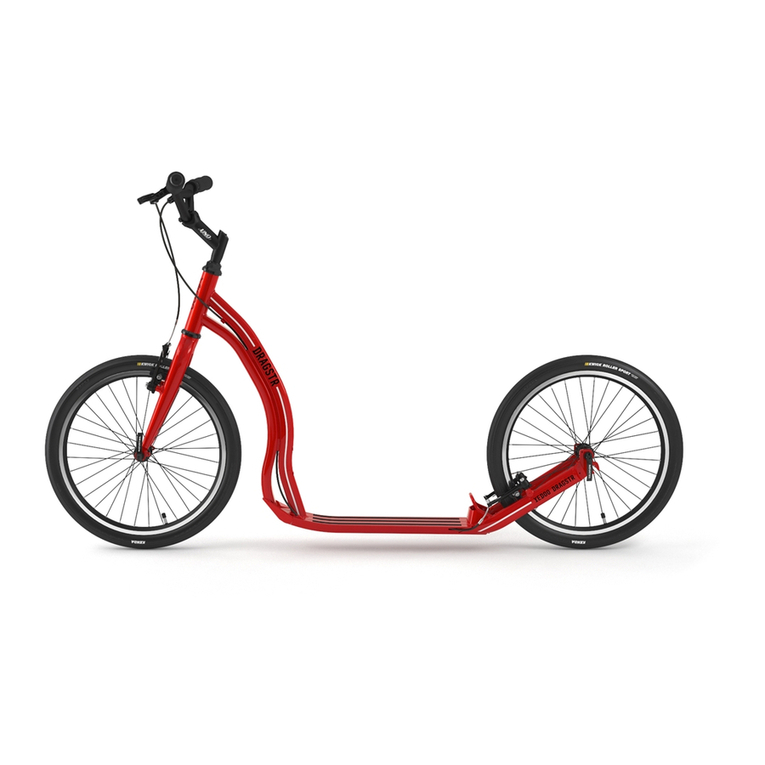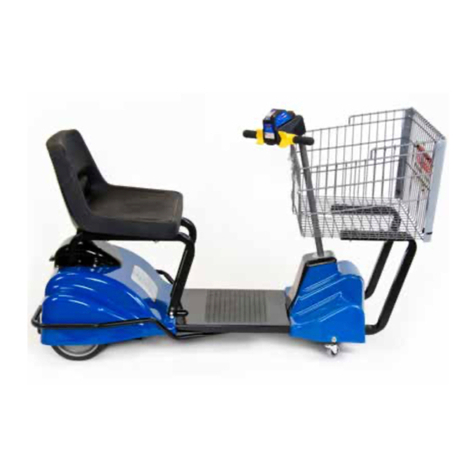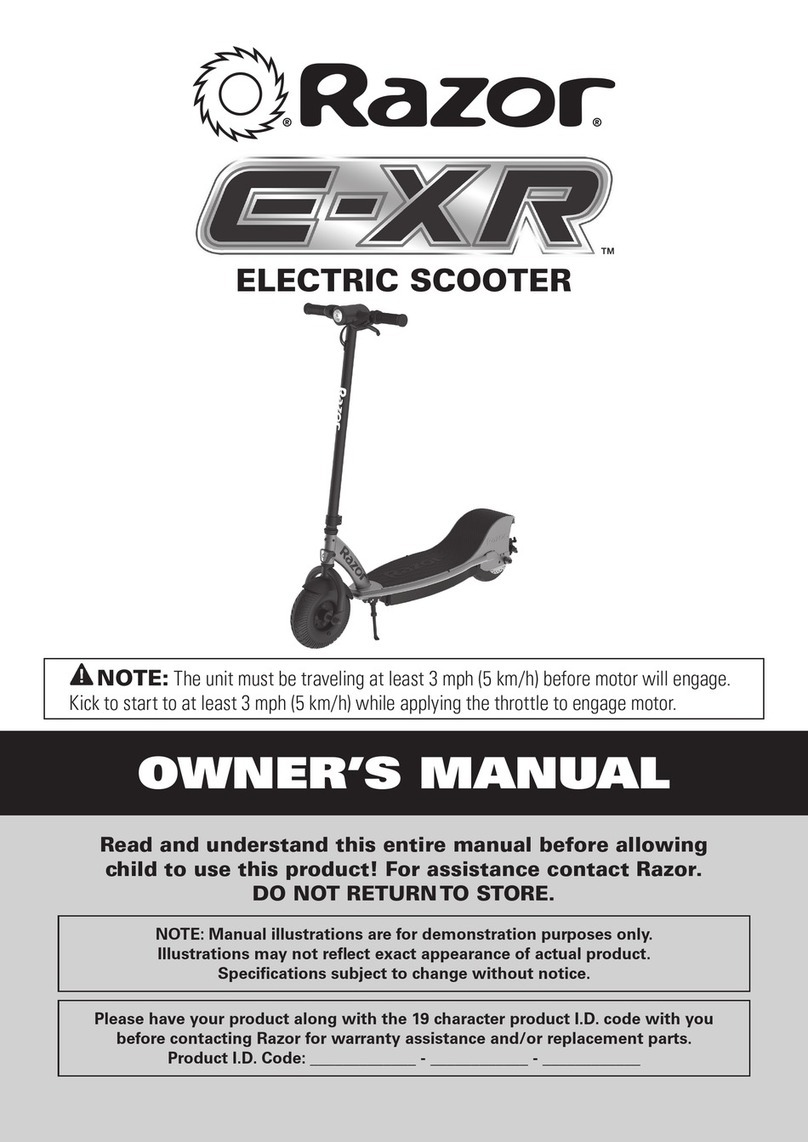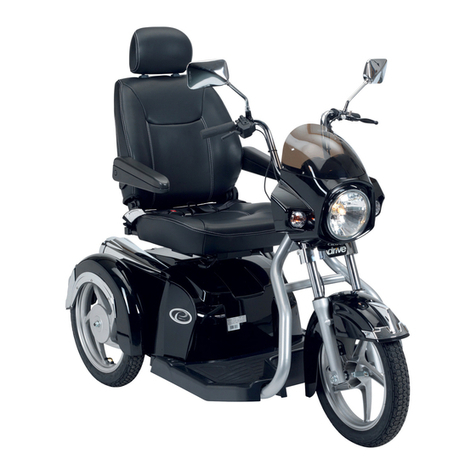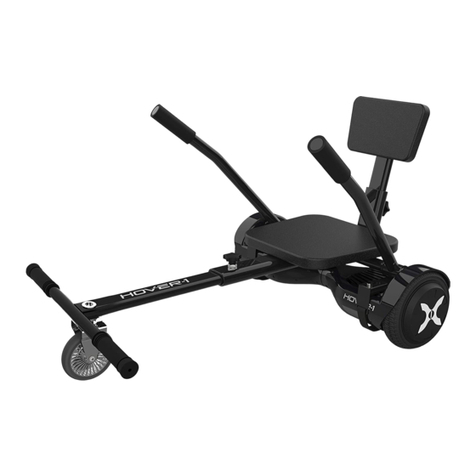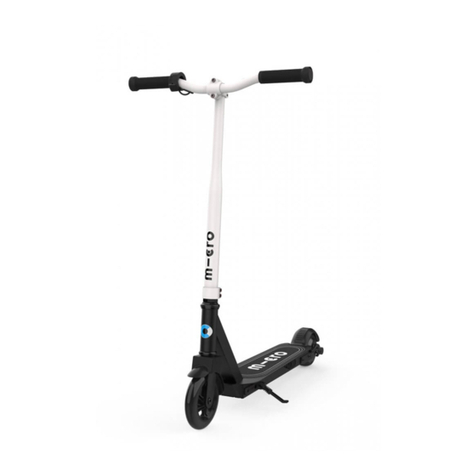KORNORGE KC7 User manual

MADE BY KORNORGE
KC7
KORNORGE ELECTRIC BIKE
USER MANUAL
(Please read the instruction manual carefully and understand the
performance of the electric bicycle before using. Please keep the instruction
manual properly)

Smart Electric Bike Instruction Manual
In the Package
Note: As we upgrade our eBikes, the one you own may be slightly different from the
one shown above, but how you use it will be the same.
2× Pedals 1× Charger 1× Owner’s
Manual
1× Warranty
Card
1× Hex Key 1×0.59 inch
Spanner
Removing the Battery
1. Open the battery lock. 2.The upper part of
the battery pops up.
3. Take out the battery
as the arrow above
indicates.
Installing the Pedals
Screw in the right pedal clockwise,
and the left counter-clockwise.
Turn the key
clockwise
Battery pops
up
Take out battery
Rear Disc Brake Rotor
Rear Rack
Rear Disc Brake Caliper
Spoke
Kickstand
Seat Tube Quick Release
Pedal
Chain Wheel
Chain
Rear Derailleur
Motor
Rear Reflector
Flywheel
Controller
Seat Tube
Saddle
Mudguard
Mudguard Stay
Brake Lever
Front Fork
Headlight
Wiring
Front Tire
Front Disc Brake Rotor
Hub
Front Disc Brake Caliper
Front Wheel Reflector
Frame
Grip Cover
Handlebar
Front Fork
Bell
Power Switch
Shifter
Crank
Battery
Display
Front Reflector
Quick Releaser

Getting Started
1. Assembling: 1) Open the box, take out your eBike, and remove
the packaging. 2) Mount the front wheel to the front fork, and
tighten the screws to lock into place. 3) Assemble and align the
handlebar upon the riser, and lock into place. 4) Walk the eBike to
ensure no abnormal sound from the turning wheels. Gently pull
the brake levers for a couple of times to ensure both the front and
rear brakes function normally. 5) Adjust the seat tube to desired
height, and lock the quick release. 6) Install the pedals and tighten
up. (Please wear a helmet when riding the eBike.)
2. Charging: Connect the DC jack of the original charger to the
charging slot of your eBike, and the AC plug to the mains. The
charger light turns from red to green when charging is complete.
(When the battery does not need charging, do not keep the AC
plug connected to the mains and do not keep the charger con-
nected to the battery. Do not charge indoors. When charging out-
doors, avoid rain or direct sun on the charger.)
3. Power on and off: Locate the power button on the left handle.
Press it to power on, and to power off, press and hold it for three
seconds. The eBike automatically powers off upon ten minutes of
inactivity
4.Display: The display in the center of the handlebar shows battery
level, speed, mode, lights, and failure report.
5. Shifting mode (motor speed): Locate the M button on the left
handle. When the power is on, press it to shift the motor speed.
Mode E/D/S corresponds to the motor-powered maximum speed
of 15 km/h (or 9.32 mph), 25 km/h (or 15.53 mph) and 32 km/h
(19.88 mph).
6. Headlight: After turning on the eBike, press the light button
located left of handlebar.

Charging Port
Grip Cover
Mode Button
Power Button & Switch
Display
Mechanic
Shifter
Accelerator
Front Light Switch
Bell Brake Lever
7. Cruise control: When the desired uniform riding speed is
reached, maintain the position of the throttle for eight seconds to
start cruising. Releasing the throttle would not affect the cruising
speed. Twist the throttle again to accelerate, or pull the brake
levers to stop cruising.
8. Riding modes:
a. Sports Mode: Power is off and there is no motor output. Pedal
and exercise.
b. Throttle Mode: When the power is on, twist the throttle to accel-
erate and start the ride without pedaling.
c. Pedal Assist Mode: When the power is on and while you are ped-
aling, the motor also provides power for an easier and more ener-
gy-efficient ride.
9.Power cut-off brakes: When you pull the brake levers, the con-
troller cuts off the motor output. The mechanical disc brakes are
also engaged. As long as the brake levers are not completely
released, Pedal Assist Mode or Throttle Mode remains disabled.
10. Removing and installing the battery: This battery is removable.
To remove it, open the battery lock, and the upper part of the bat-
tery pops up. Take out the battery in the upward direction. To
install the battery, start with the bottom of the battery and slide it
down through the battery tube. Make sure the discharge port is
connected well with the plug of the connector. Push in the upper
part, clip it in to the battery tube, and lock the battery. (For battery
replacement upon damage, please contact our official customer
service.)

Installing the Front Wheel
I. Basic mechanical principle with the quick release lever
Turn the adjusting nut clockwise to increase clamping, and anti-clockwise to
decrease.
For the quick release lever to be in the CLOSE position, turn the adjusting nut clock-
wise. As the nut screws inwards, the wheel is clamped onto the frame and locked
into the correct position.
II. How to install
1. Open the quick release lever, and insert the front wheel all the way into the drop-
outs of the front fork.
2. With your left hand, turn the adjusting nut clockwise to fasten up, and with your
right hand, close the quick lease lever. Continue to turn the adjusting nut till the
lever runs parallel to the hub (as indicated below) and resistance from the lever is
felt.
3. Hold the legs of the front fork with your fingers, and use your palm to press on the
quick release lever to lock into place. The CLOSE mark should face outwards, and
the lever should be ahead of the legs or parallel to them (as indicated below).
OPEN Position
Adjusting Nut
Adjusting Nut
Stronger
Weaker
Quick Release
Lever CLOSE Position
Adjusting Nut
Correct Wrong
1/8 of a circle for each turn of the adjusting nut

Gears
Some KORNORGE eBikes come with gears, which consists of:
• Rear sprocket cluster, called freewheel or cog set
• Rear derailleur
• Shifter
• Control cable
• Front sprocket, called chaining
• Drive chain
The gear mechanism differs in ergonomic design, performance and
price.
A downshift is a shift to a lower or slower gear, which makes pedaling
easier. An upshift is a shift to a higher or faster gear, which makes
pedaling harder. In practice, you can upshift to go faster, and you can
downshift to go uphill.
A shift is possible only when you are pedaling forward, i.e. the drive
chain is moving forward and under some tension.
CAUTION
Never shift when pedaling backward. Also, do not pedal backwards
after a shift. Either action may jam the chain and cause serious
damage to your eBike.

Derailleur System
The derailleur system includes front and rear derailleurs, shift levers,
and derailleur control cables. For smooth shifting, all components
must function properly.
Although the front and rear derailleurs are initially adjusted in the
factory, you need to inspect them before each ride.
To begin, twist the shifter to the largest number indicated, and the
cable shall loosen the anchor bolt on the rear derailleur, placing the
chain on the smallest sprocket. Adjust the high limit screw so that
the guide pulley and the smallest sprocket are lined up vertically.
Re-tighten the cable, pull out any slack, and re-tighten the anchor
bolt securely. Shifting through the gears, making sure that each gear
is achieved quietly and swiftly.
If necessary, use the barrel adjuster to fine tune the cable tension by
turning it the direction you want the chain to go. For example,
turning clockwise loosens cable tension and moves the chain away
from the wheel, while turning counter-clockwise tightens cable
tension and direct the chain towards the wheel.

Display
Item
Headlight
Current Speed
Current battery level
Current mode
Failures
The icon lights up when the
headlight is on, and off when the
headlight is off.
Current speed
Current battery level
Current riding mode
E1: Abnormal phase wire
E2: Abnormal current
E3: Abnormal braking
E4: Abnormal throttle
E5: Abnormal motor Hall-effect
E6: Communication failure
Display Sample
Image Description

Buttons
Item
Power button
M button
Light button
Press and hold for three seconds to
power on or off the eBike.
Press to switch among modes
Press to turn on/off the front light
Icon Description
Display Setting
1. When the power is on, press and hold both the power button and M
button at the same time to change unit of speed between km/h and
mph.
2. When the power is on, press and hold both the power button and the
light button at the same time for about twenty seconds to clear mile-
age.

Specification
Build
KC7Model
Body material
Expanded size
Packing size
Wheelbase
Pedal ground clearance
Wheel hub
Body color
Aluminum alloy frame
1510*240*790 mm
(59.44*9.44*31.10 inches)
1123 mm (44.21 inches)
120 mm (4.72 inches)
26 inches
Black / White
Performance
Weight
Load
41 kg (90.39 lbs.)
120 kg (264.55 lbs.)
Average speed 25 km/h (15.53 mph)
32 km/h (19.88 mph)
Max Speed
Power consumption
per hundred kilometers 1.08 kWh
Range in throttle mode
Range in pedal assist
mode
Hill climbing capacity
Operating temperature
IP rating
1790*640*1060 mm
(70.47*25.19*41.73 inches)
50±3 km (31.06±1.86 mi)
60±5 km (37.28±3.11 mi)
15 degree
-10~45 degrees Celsius
(14-113 degrees Fahrenheit)
IP54

Specification
Model
Battery Type
KC7
18650 lithium ion
Battery Capacity 12.5Ah
Battery rated voltage 36V
Charging voltage DC42V
Charger input voltage AC100-220V
Charging time
Core
Features
6-7Hours
Motor Type
Independent high
speed spoke motor
Motor rated power 350W
Motor rated speed 260 r/min
Motor rated Voltage 36V
Controller under voltage
Value 31±1V
15A
Controller over current
value
Headlight
Rear light
Yes
No
Yes
Yes
Front and rear disc
brakes
Optional
Cruise
Speed sensor
Adjustable seat height
Braking
Customized stickers
Yes
Note:
The max speed may vary, depending on the battery level, load, tire pressure, terrain, lubri-
cation state of the chain and bearings, etc.
The ranges are determined upon tests at the ambient temperature of 25° C (or 77° F), at the
speed of 15 to 20 km/h (or 9.32 to 12.43 mph), on smooth and firm terrain, with a load of 120
kg (or 264.55 lbs.), and within an uninterrupted period from full to zero battery level. The
ranges may vary, depending on your riding behavior, ambient temperature, load, tire
pressure, terrain, etc.

Circuit Diagram
Left Power Cut-off Brake Levers
Right Power Cut-off Brake Levers
High
speed
Motor
Booster
Power switch
Headlight
5V
Phase Wire A
Ha
Hb
Hc
GND
Phase Wire B
Phase Wire C
GND
5V
Hall2
GND
GND
GND
Brake
GND
Brake
GND
Power_36V Power_36V
Display
36V Battery Pack
DC2.1
Charging Port
36V
GND
3.3V
Y-GND
36V Electrolock
Speed Sensor
K1
K2
Mode Shifter
Mode M
Headlight
Electrolock
_36V Electrolock
_36V
RX
TX
TX
RX
Front Light
Button
Controller

Battery & Charging
ATTENTION
●Do not connect the positive to negative, or vice versa. Do not
damage, disassemble, or short-circuit the battery. Avoid water,
other liquid, or other foreign matter inside the battery to prevent
short circuit.
●Instructions in this manual must be followed when charging the
battery, otherwise the owner shall take sole responsibility for any
consequences.
●Charge the battery only at the temperature between 0°C (or 32° F)
and 45 ° C (or 113 ° F), and discharge at the temperature between
-20°C (or -4°F) and 60°C (or 140°F). The charging current should not
exceed 2A. Charge only in a well-ventilated area, away from sun
and heat.
●Use the original charger from the package to charge the battery.
Connect the charger and battery before plugging the charger into
the mains. Do not charge the battery for over 6 hours each time.
●When charging, if the charging indicator appears abnormal, a
smell is released, or the charger overheats, stop charging immedi-
ately. Service or replace the charger.
●To stop charging, unplug from the mains before disconnecting
the charger and battery.
●When the charging indicator turns green, stop charging.
●Do not leave the charger connected to any AC power source
when not charging.
●When not in use, store the battery in a dry and cool place. Keep
away from fire, heat and high temperature. Do not put the battery
in acid or alkaline liquid. Make sure to charge the battery for two
hours each month.
●Before using the charger to charge a different battery, note the
battery type and voltage that the charger may apply to.
●It is advisable not to carry the charger with your eBike. If you
must, place the charger in a toolbox upon shock absorption treat-
ment.
●Do not dissemble the charger or replace the parts and compo-
nents in the charger on your own.
Waste battery is classified as hazardous. Do not dissemble the
waste battery on your own. It should be collected and recycled
properly.

Riding your eBike
●Do not use the eBike before reading this manual carefully and
knowing your eBike thoroughly.
●This eBike is designed for riders aged 16-45. Anyone aged below 16
is strictly forbidden to ride this eBike.
●Do not lend your eBike to anyone who do not know how to use it,
so as to avoid harm.
●When adjusting the steerer tube and seat tube, do not expose the
minimum insertion marks.
●Before riding, check the tire pressure. It is advisable to maintain at
35-45 PSI.
●Before riding, ensure the power, lights, handles, brakes, wheels,
reflectors and others are in good condition.
●Before carrying people or objects on your eBike, learn the local
laws and regulations, and abide by them.
●Do not exceed the load capacity of 120 kg (or 264.60 lbs.).
●Wear a helmet, and obey traffic rules.
●Obey local traffic rules to keep to the right or left.
●Do not ride on any motorized lane or in any pedestrian crowd.
●It is advisable not to go over 15 km/h (or 9.32 mph) when riding on
any non-motorized lane, downhill, or paved road.
●Slow down in rain or snow as required braking distances increase.
●It is advisable not to ride in storms or any extreme weather.
●Avoid impact on the motor.
●Keep the bearings lubricated.
●Do not park your eBike in any lobby, walkway, evacuation stairway,
or emergency entrance/exit.
●Do not charge or park your eBike inside any residential building.
Keep away from combustibles when charging. Charging should not
exceed 6 hours each time.

Maintenance
Disclaimer
●The front and rear wheels should be aligned to the center of the
front fork and frame.
●Park away from direct sunlight and rain.
●Do not rinse the eBike. Wipe with a damp cloth to clean.
●Check the motor and brakes frequently. Do not oil the braking
system.
●Regularly check all screws and keep them fastened.
●Recommended torque specs: handlebar screw 52.08-69.44 lbsf.in,
steering stem screw 151.90-173.60 lbsf.in, saddle screw
151.90-217.00 lbsf.in, and wheel screw 277.70-390.60 lbsf.in.
●Regularly check the tension of the chain, which can be adjusted via
the chain regulator.
●Frequently check the tires for scratches, cracks or excessive wear.
The inner tube and valve should be perpendicular to the wheel hub.
Punctured, damaged or excessively worn inner tube and tire must
be replaced immediately. Please contact professional technicians.
●It is forbidden to modify key structural parts including the frame,
front fork and steerer tube, and any electrical parts. If damaged,
replace with identical parts from our factory. Otherwise, the warran-
ty shall be void and the owner shall take sole responsibility for any
consequence.
●For more information, please visit our official website: www.kornorge.com
Our company reserves the right to modify and give final interpreta-
tion to the product model, specification, and other information con-
tained in this manual.
● The functions of the specific model referred to in this manual
apply to this specific model only.
● The product model, specification, and other information con-
tained in this manual is subject to any modification or change with-
out notice.
● Without the prior written permission of the company, the contents
of the manual may not be copied, modified, reprinted, disseminated
or published in any form.
● Please read this manual carefully before using the product, and
operate in accordance with the manual. Otherwise, the company
shall not be liable for any personal or property damage, including
damage to the product, caused by misuse or abuse.

kornorge.com
kornorge.support
Table of contents
Other KORNORGE Scooter manuals
